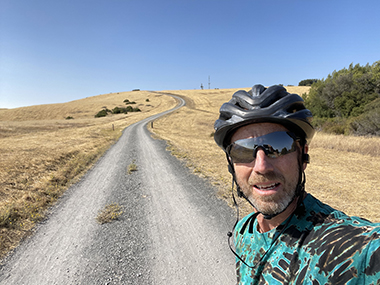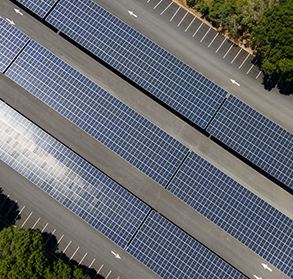1. Tell us a bit about yourself, your background, and how your path led to where you are today.
I am a 2001 alumni of Kresge College and majored in Earth Sciences. My journey to both UCSC, and sustainability is due to a series of random circumstances. I had a strong connection to the environment and sustainability, so it seemed natural to me to work in energy efficiency, where I could use my analytical skills and my
 math skills to improve how we live on this planet. Things that impacted my path were the people and movements I met through going to Grateful Dead shows in the 1980s and 1990s (Greenpace, SEVA, Rex Foundation, etc); spending a couple of years living in Lake Tahoe; working in the health food industry (New Leaf, Whole Foods, and a few other smaller markets); the various people I met in Santa Cruz, that influenced how I eat, and live on this planet. Let’s say it was one big awareness opening path, that I am still on.
math skills to improve how we live on this planet. Things that impacted my path were the people and movements I met through going to Grateful Dead shows in the 1980s and 1990s (Greenpace, SEVA, Rex Foundation, etc); spending a couple of years living in Lake Tahoe; working in the health food industry (New Leaf, Whole Foods, and a few other smaller markets); the various people I met in Santa Cruz, that influenced how I eat, and live on this planet. Let’s say it was one big awareness opening path, that I am still on.2. Being responsible for great energy savings initiatives on campus, can you tell us a bit about what you do, and the importance of conserving energy?
My main area of impact is working on projects that reduce the campus’ energy usage. These can be projects that our department develops, but usually my role is to take somebody’s project, review it, and if I believe it is feasible, I recommend it for funding to the campus leadership. I also value working with students, supporting their education through internships and through the work that they do as paid staff in our Energy Department.
What kinds of projects? Well they can vary widely, but the most recent projects I was involved with were the solar array at East Remote Parking, and the LED lighting that was installed at Humanities, Social Sciences, Earth and Marine Sciences, and Natural Sciences buildings. In the past, we also have worked on water conservation as well. The work of the Energy Department is very collaborative, we simply help people with great ideas to get their ideas done.
3. Can you share with us how the partnership with PG&E came about, that provided a grant for lighting retrofit replacing all bulbs with LED in Soc Sci 1 and 2, and other buildings after?
The partnership with PG&E is the result of decades of growing collaboration between the state of California (California Energy Commission), and the utility customers. Although not perfect, it is one of the best partnerships in the country. This collaboration incentivized the utilities and their customers to save energy. It’s actually less expensive to save energy than it is to build power plants and transmission lines.
4. What about solar energy? Can you tell us about projects already in place on campus and what the future plans are?
We have two major solar projects currently on the UCSC campus. One was built in 2013, and is on the roof of the  McHenry Library. The second project is at the East Remote Parking lot, and that was completed in 2021. We have plans to install more solar panels throughout all the UCSC managed properties, thanks to increased support from campus leadership, and the fact that the cost of electricity is going up, and the cost of solar is becoming more economical.
McHenry Library. The second project is at the East Remote Parking lot, and that was completed in 2021. We have plans to install more solar panels throughout all the UCSC managed properties, thanks to increased support from campus leadership, and the fact that the cost of electricity is going up, and the cost of solar is becoming more economical.
5. You have done a lot for water conservation on our campus as well, can you give us a brief summary of what has been accomplished?
Water conservation at UCSC has been primarily through increased water leak detection. What makes it difficult at UCSC is that it is built on Karst topography, which means lots of caves and openings underneath our land. This impacts leak detection because leaks don’t always surface when they happen, so we really need to have water monitoring systems to find these leaks. We have that system now, and it helps the campus find and repair leaks efficiently.
The campus also has installed highly efficient irrigation systems, and our campus construction projects emphasize natural landscape. This natural landscape doesn’t need any more water than our climate provides.
6. What is the most rewarding part of your work?
Having impact, working with students, and watching them learn and grow at the university. I also really enjoy being able to work and play in this amazing community. I really enjoy cycling and running throughout the campus. Rumor has it you can find me running the pick up basketball courts with the students and staff at East Field too. I really enjoy that as well.
7. What does Sustainability mean to you?
Sustainability means many things to me. Living in a way that doesn’t jeopardize future generations and their quality of life. I like to think of humanity at its best, living on the earth like a healthy bacteria lives in our gut. It’s there to help us digest, and live. We have a choice, we can either exist on this planet as a healthy bacteria, or as a cancer.
We hire students to work in our department, and I encourage anybody interested in energy, environmental, or sustainability work to reach out to find out more.
9. Lastly, what do you do for fun outside of work?
I live in Santa Cruz to enjoy this climate as much as possible. I spend my days running, cycling, playing basketball, and travelling throughout California and the world. I have travelled quite a bit, and hope to continue travelling worldwide again soon.
